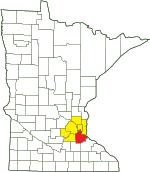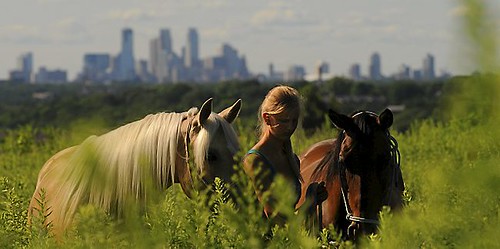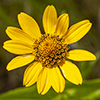Pilot Knob
About • Location • Activities • Ecology
About |
Ownership |
|
Links |
|
Pilot Knob Preservation Association National Park Service, Mississippi National River & Recreation Area |
Overview |
Pilot Knob is an historic site in Mendota Heights on the east bank of the Minnesota River. Two overlooks provide spectacular vistas of Fort Snelling, the Minnesota and Mississippi Rivers, and the Minneapolis skyline. A half-mile of paved and mowed trails include interpretive signs that describe the history of the site. The trail connects to Dakota County’s Big Rivers Regional Trail, a paved bike trail. Bald Eagles and migrating raptors are often seen flying overhead. |
History |
Pilot Knob is a part of the 127-acre Oȟéyawahe/Pilot Knob, a place of cultural importance to the Dakota community. The name translates to “a hill much visited.” It served as a burial site for for Dakota Villages along the Minnesota River. It is here that the Dakota signed a treaty in 1851 that transferred millions of acres of land to the United States. In 2006, the City of Mendota Heights acquired 25 acres on the hill. On March 14, 2017, Pilot Knob was added to the National Registed of Historic Places. |
Management |
Overhead power lines were buried underground, brush was cut and removed, prairie was restored, and wildflowers and oak trees were planted. |
Comments |
|
Activities |
||||
Walking Trail running Biking Mountain biking Horseback riding Picnicking Camping Swimming Boating Canoeing Birding Nature photography Horseshoes Volleyball Geocaching Cross country skiing Skate-skiing Winter hiking Snowshoeing Snowmobiling |
||||
Trails |
||||
|
||||
Hunting and Fishing |
||||
|
Ecology |
|||||
Ecological Classification |
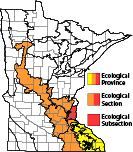 |
||||
| Ecological Province | Eastern Broadleaf Forest Province |
||||
| Ecological Section | Minnesota & NE Iowa Morainal |
||||
| Ecological Subsection | St. Paul-Baldwin Plains and Moraines |
||||
| Land Type Association | Wescott Moraine |
||||
Native Plant Communities* |
|||||
Not mapped (10/11/2021) |
|||||
| * Source: The Minnesota Biological Survey, Minnesota Department of Natural Resources, Division of Ecological Resources | |||||
Natural Features |
|||||
|
|||||
Visitor Photos |
||
Share your photo of this destination. |
||
This button not working for you? |
||
Kirk Nelson |
||
 |
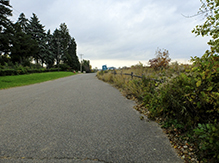
|
|
Sheep grazing |
||
Road to Parking |
||
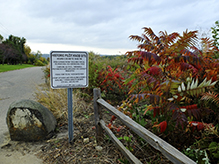
|
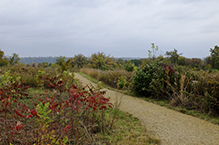 |
|
Trail from parking area |
||
Sign |
||
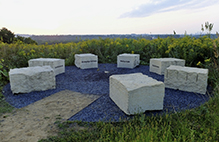 |
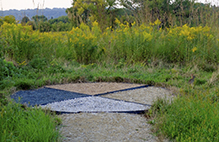 |
|
Council Fires Overlook |
Overlook area |
|
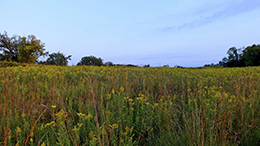 |
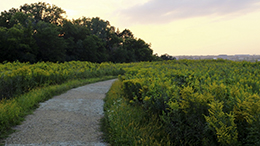 |
|
| Up slope from Council Fires Overlook | Trail |
|
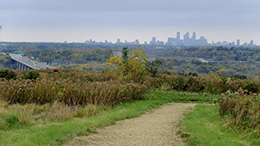 |
||
| View of Minneapolis |
|
|
MinnesotaSeasons.com Photos |
||
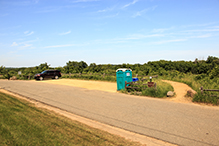 |
 |
|
Parking |
A brochure with a map is available at the parking area | |
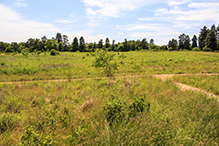 |
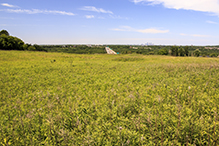 |
|
Restored prairie |
||
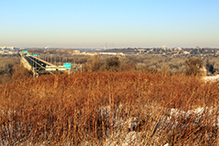 |
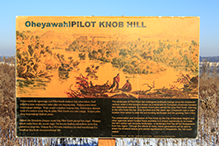 |
|
View from the top |
Interpretive sign | |
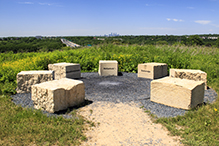 |
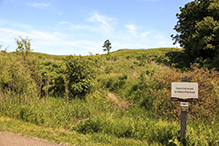 |
|
Council Fires Overlook |
Future trail |

Visitor Videos |
||
Share your video of this destination. |
||
This button not working for you? |
||
|
Other Videos |
||
Conservation Grazing at Pilot Knob Hill |
About
Published on Jul 19, 2013 As part of a long-term prairie reconstruction effort at Pilot Knob Hill in Mendota Heights, Great River Greening introduced horses and ponies for conservation grazing on a warm, sunny morning in July. Conservation grazing is a restoration technique that introduces grazing livestock to feed on nonnative grasses as a means to increase the biodiversity of the native landscape. In addition to conservation grazing, other efforts, including prescribed burning, mowing, and removal of buckthorn and sumac invasive species, have been implemented throughout the year. This combination of conservation efforts is carefully planned for native species to thrive and nonnative species to be eliminated from the area. The city of Mendota Heights is funding this event through a grant from the National Trust for Historic Preservation. About Pilot Knob Located on a high, prominent hill on the east bank of the Minnesota River near where it meets the Mississippi River, Pilot Knob provides sweeping views of both, as well as Fort Snelling State Park, and downtown Minneapolis and St. Paul. It attracts numerous uncommon and rare bird species and provides critical habitat for native grassland wildlife that includes eagles, migrating raptors and songbirds, long-eared owls, wild turkeys, and White-tailed Deer. Prairie Restoration and Community Stewardship About Great River Greening www.greatrivergreening.org |
Butterflies |
About
Published on Aug 12, 2016 10 AUG 2016 Butterflies and flowers on Pilot Knob, Mendota Heights, MN. |

Visitor Sightings |
|
Share your sightings or comments about of this destination. |
|
This button not working for you? |
|
Kirk Nelson |
||
Comments |
Known to Dakota people as Oheyawahi, "the hill much visited," Pilot Knob is a place of distinctive historical, cultural, and environmental importance, a sacred site, a landmark of Minnesota's beginnings. Pilot Knob is located on the east end of the Mendota Bridge, south of Highway 55 in Mendota Heights, Minnesota. — Pilot Knob Preservation Association |
Plants |
||
| leadplant (Amorpha canescens) |  |
|
MinnesotaSeasons.com Sightings |
Visits |
1/15/2017 6/7/2017 |
Amphibians |
||
Bacteria, Viruses, and Other Pathogens |
||
| Pseudomonas syringae pv. tagetis (Pst) (A pathogen of Asteraceae) |  |
|
Birds |
||||||||
|
||||||||
American Goldfinch (Spinus tristis) American Robin (Turdus migratorius) Barn Swallow (Hirundo rustica) Clay-colored Sparrow (Spizella pallida) Common Yellowthroat (Geothlypis trichas) |
||||||||
Fungi and Lichens |
||
| Crown Rust (Puccinia coronata) |  |
|
Insects and Arachnids |
||||||||
|
||||||||
blue dasher (Pachydiplax longipennis) Carolina grasshopper (Dissosteira carolina) clay-colored leaf beetle (Anomoea laticlavia) common green darner (Anax junius) common ringlet (Coenonympha california) goldenrod bunch gall midge (Rhopalomyia solidaginis) goldenrod gall fly (Eurosta solidaginis) midland clubtail (Gomphurus fraternus) |
||||||||
Mammals |
||
Eastern Cottontail (Sylvilagus floridanus) |
 |
|
Plants |
||
Minnesota Biodiversity Atlas and Minnesota Biological Survey Vegetation Releves Plant List |
||
|
absinthe wormwood (Artemisia absinthium) alfalfa (Medicago sativa ssp. sativa) American plum (Prunus americana) American stinging nettle (Urtica gracilis ssp. gracilis) American vetch (Vicia americana) annual fleabane (Erigeron annuus) big bluestem (Andropogon gerardi) bird’s-foot trefoil (Lotus corniculatus var. corniculatus) black medick (Medicago lupulina) black raspberry (Rubus occidentalis) black-seeded plantain (Plantago rugelii var. rugelii) boxelder (Acer negundo var. negundo) bracted spiderwort (Tradescantia bracteata) bull thistle (Cirsium vulgare) bur oak (Quercus macrocarpa var. macrocarpa) Canada anemone (Anemonastrum canadense) Canada moonseed (Menispermum canadense) Canada thistle (Cirsium arvense) common buckthorn (Rhamnus cathartica) common burdock (Arctium minus) common dandelion (Taraxacum officinale ssp. officinale) common evening primrose (Oenothera biennis) common hackberry (Celtis occidentalis) common milkweed (Asclepias syriaca) common mullein (Verbascum thapsus ssp. thapsus) common ragweed (Ambrosia artemisiifolia) common three-square (Schoenoplectus pungens) common yarrow (Achillea millefolium) crown vetch (Securigera varia) cut-leaved coneflower (Rudbeckia laciniata var. laciniata) early figwort (Scrophularia lanceolata) eastern redcedar (Juniperus virginiana var. virginiana) field pennycress (Thlaspi arvense) field thistle (Cirsium discolor) fringed brome (Bromus ciliatus) giant goldenrod (Solidago gigantea) golden alexanders (Zizia aurea) gray dogwood (Cornus racemosa) gray-headed coneflower (Ratibida pinnata) green ash (Fraxinus pennsylvanica) ground ivy (Glechoma hederacea) heart-leaved four o’clock (Mirabilis nyctaginea) hoary alyssum (Berteroa incana) hoary vervain (Verbena stricta) Indian hemp (Apocynum cannabinum) Indiangrass (Sorghastrum nutans) June grass (Koeleria macrantha) large-flowered beardtongue (Penstemon grandiflorus) late goldenrod (Solidago altissima) leafy spurge (Euphorbia virgata) little bluestem (Schizachyrium scoparium) orange daylily (Hemerocallis fulva) oxeye daisy (Leucanthemum vulgare) Philadelphia fleabane (Erigeron philadelphicus var. philadelphicus) pineapple-weed (Matricaria discoidea) plains cottonwood (Populus deltoides ssp. molinifera) prairie alumroot (Heuchera richardsonii) prairie blue-eyed grass (Sisyrinchium campestre) prairie peppergrass (Lepidium densiflorum) prairie spiderwort (Tradescantia occidentalis var. occidentalis) purple meadow-rue (Thalictrum dasycarpum) quaking aspen (Populus tremuloides) red osier dogwood (Cornus sericea ssp. sericea) redtop (Agrostis gigantea) reed canary grass (Phalaris arundinacea) rough cinquefoil (Potentilla norvegica) rough oxeye (Heliopsis helianthoides var. scabra) slender willow (Salix petiolaris) smooth Solomon’s seal (Polygonatum biflorum var. commutatum) stiff goldenrod (Solidago rigida ssp. rigida) swamp milkweed (Asclepias incarnata ssp. incarnata) tall cinquefoil (Drymocallis arguta) tall tumble mustard (Sisymbrium altissimum) Tatarian honeysuckle (Lonicera tatarica) timothy (Phleum pratense ssp. pratense) Virginia creeper (Parthenocissus quinquefolia) water smartweed (Persicaria amphibia) western poison ivy (Toxicodendron rydbergii) white campion (Silene latifolia ssp. alba) white clover (Trifolium repens ssp. repens) wild bergamot (Monarda fistulosa) wolfberry (Symphoricarpos occidentalis)
Acer negundo var. negundo (boxelder) Achillea millefolium (common yarrow) Agrostis gigantea (redtop) Ambrosia artemisiifolia (common ragweed) Andropogon gerardi (big bluestem) Anemonastrum canadense (Canada anemone) Apocynum cannabinum (Indian hemp) Arctium minus (common burdock) Artemisia absinthium (absinthe wormwood) Asclepias incarnata ssp. incarnata (swamp milkweed) Asclepias syriaca (common milkweed) Berteroa incana (hoary alyssum) Bromus ciliatus (fringed brome) Celtis occidentalis (common hackberry) Cirsium arvense (Canada thistle) Cirsium discolor (field thistle) Cirsium vulgare (bull thistle) Cornus racemosa (gray dogwood) Cornus sericea ssp. sericea (red osier dogwood) Drymocallis arguta (tall cinquefoil) Erigeron annuus (annual fleabane) Erigeron philadelphicus var. philadelphicus (Philadelphia fleabane) Euphorbia virgata (leafy spurge) Fraxinus pennsylvanica (green ash) Glechoma hederacea (ground ivy) Heliopsis helianthoides var. scabra (rough oxeye) Hemerocallis fulva (orange daylily) Heuchera richardsonii (prairie alumroot) Juniperus virginiana var. virginiana (eastern redcedar) Koeleria macrantha (June grass) Lepidium densiflorum (prairie peppergrass) Leucanthemum vulgare (oxeye daisy) Lonicera tatarica (Tatarian honeysuckle) Lotus corniculatus var. corniculatus (bird’s-foot trefoil) Matricaria discoidea (pineapple-weed) Medicago lupulina (black medick) Medicago sativa ssp. sativa (alfalfa) Melilotus officinalis (yellow sweet clover) Menispermum canadense (Canada moonseed) Mirabilis nyctaginea (heart-leaved four o’clock) Monarda fistulosa (wild bergamot) Oenothera biennis (common evening primrose) Parthenocissus quinquefolia (Virginia creeper) Parthenocissus vitacea (woodbine) Penstemon grandiflorus (large-flowered beardtongue) Persicaria amphibia (water smartweed) Phalaris arundinacea (reed canary grass) Phleum pratense ssp. pratense (timothy) Plantago rugelii var. rugelii (black-seeded plantain) Polygonatum biflorum var. commutatum (smooth Solomon’s seal) Populus deltoides ssp. molinifera (plains cottonwood) Populus tremuloides (quaking aspen) Potentilla norvegica (rough cinquefoil) Prunus americana (American plum) Quercus macrocarpa var. macrocarpa (bur oak) Ratibida pinnata (gray-headed coneflower) Rhamnus cathartica (common buckthorn) Rubus occidentalis (black raspberry) Rudbeckia laciniata var. laciniata (cut-leaved coneflower) Salix petiolaris (slender willow) Schizachyrium scoparium (little bluestem) Schoenoplectus pungens (common three-square) Scrophularia lanceolata (early figwort) Securigera varia (crown vetch) Silene latifolia ssp. alba (white campion) Sisymbrium altissimum (tall tumble mustard) Sisyrinchium campestre (prairie blue-eyed grass) Solidago altissima (late goldenrod) Solidago gigantea (giant goldenrod) Solidago rigida ssp. rigida (stiff goldenrod) Sorghastrum nutans (Indiangrass) Symphoricarpos occidentalis (wolfberry) Taraxacum officinale ssp. officinale (common dandelion) Thalictrum dasycarpum (purple meadow-rue) Thlaspi arvense (field pennycress) Toxicodendron rydbergii (western poison ivy) Tradescantia bracteata (bracted spiderwort) Tradescantia occidentalis var. occidentalis (prairie spiderwort) Trifolium repens ssp. repens (white clover) Urtica gracilis ssp. gracilis (American stinging nettle) Verbascum thapsus ssp. thapsus (common mullein) Verbena stricta (hoary vervain) |
||

Rare Bee
During a bumble bee survey conducted in July, 2016, a rusty patched bumble bee was found here.
Created: 12/22/2016 Last Updated: © MinnesotaSeasons.com. All rights reserved. |

